New paper: Change detection in urban settings with pixel-based+obia methods
 Friday, July 29, 2016 at 4:08PM
Friday, July 29, 2016 at 4:08PM Xiao, P, X Zhang, D Wang, M Yuan, X Feng, M Kelly. 2016. Change detection of built-up land: A framework of combining pixel-based detection and object-based recognition. ISPRS Journal of Photogrammetry and Remote Sensing 119; 402–414
This study proposed a new framework that combines pixel-level change detection and object-level recognition to detect changes of built-up land from high-spatial resolution remote sensing images.
 obia,
obia,  remote sensing
remote sensing New report in press: Mapping forest conditions for the California spotted owl
 Thursday, July 28, 2016 at 8:22AM
Thursday, July 28, 2016 at 8:22AM Kelly, M. In Press. Mapping Forest Conditions Past, Present, and Future. Chapter 6 in Gutiérrez, R.J.; Manley, Patricia N.; Stine, Peter A., tech. eds. [In press]. The California spotted owl: current state of knowledge. Gen. Tech. Rep. PNW-GTR. Albany, CA: U.S. Department of Agriculture, Forest Service, Pacific Southwest Research Station.
Mapping and mapped data have always been critical to public land managers and researchers to identify and characterize wildlife habitat across scales, to monitor species and habitat change, and to predict and plan for future scenarios. Maps and mapping protocols are often incorporated into wildlife and habitat management plans, as is the case with the California spotted owl (Strix occidentalis occidentalis), a subspecies of management concern. In this chapter I have focused on the use of mapping technology that can be used to aid in the analysis of owl use of forested habitat.
New paper: Mapping forest fuel treatments using Lidar
 Tuesday, June 28, 2016 at 8:36AM
Tuesday, June 28, 2016 at 8:36AM Su, Y, Q Guo, B M Collins, D L Fry, T Hu, and M Kelly. 2016. Forest fuel treatment detection using multi-temporal airborne lidar data and high-resolution aerial imagery: a case study in the Sierra Nevada Mountains, California. International Journal of Remote Sensing 37(14): DOI: 10.1080/01431161.2016.1196842
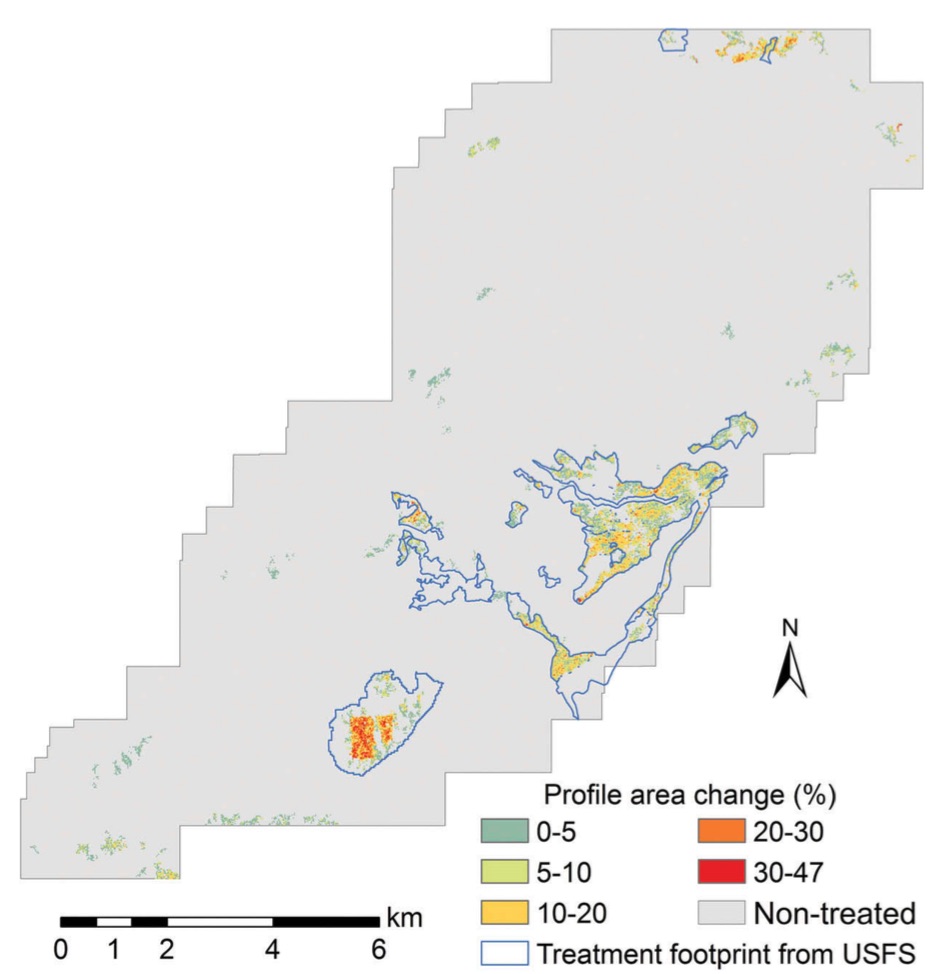 Forest change detection using lidarTreatments to reduce forest fuels are often performed in forests to enhance forest health, regulate stand density, and reduce the risk of wildfires. Although commonly employed, there are concerns that these forest fuel treatments (FTs) may have negative impacts on certain wildlife species. Often FTs are planned across large landscapes, but the actual treatment extents can differ from the planned extents due to operational constraints and protection of resources (e.g. perennial streams, cultural resources, wildlife habitats). Identifying the actual extent of the treated areas is of primary importance to understand the environmental influence of FTs. Light detection and ranging (lidar) is a powerful remote-sensing tool that can provide accurate measurements of forest structures and has great potential for monitoring forest changes. This study used the canopy height model (CHM) and canopy cover (CC) products derived from multi-temporal airborne laser scanning (ALS) data to monitor forest changes following the implementation of landscape-scale FT projects.
Forest change detection using lidarTreatments to reduce forest fuels are often performed in forests to enhance forest health, regulate stand density, and reduce the risk of wildfires. Although commonly employed, there are concerns that these forest fuel treatments (FTs) may have negative impacts on certain wildlife species. Often FTs are planned across large landscapes, but the actual treatment extents can differ from the planned extents due to operational constraints and protection of resources (e.g. perennial streams, cultural resources, wildlife habitats). Identifying the actual extent of the treated areas is of primary importance to understand the environmental influence of FTs. Light detection and ranging (lidar) is a powerful remote-sensing tool that can provide accurate measurements of forest structures and has great potential for monitoring forest changes. This study used the canopy height model (CHM) and canopy cover (CC) products derived from multi-temporal airborne laser scanning (ALS) data to monitor forest changes following the implementation of landscape-scale FT projects.
 forests,
forests,  lidar,
lidar,  remote sensing,
remote sensing,  snamp
snamp New paper: Bridging the information gap: A webGIS tool for rural electrification in data-scarce regions
 Saturday, March 19, 2016 at 10:33AM
Saturday, March 19, 2016 at 10:33AM 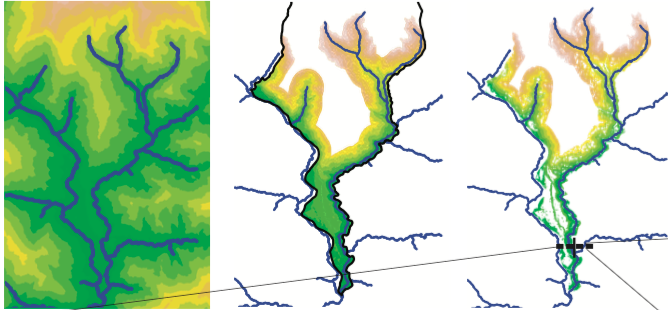
Müller, M F, S E Thompson, and M Kelly. 2016. Bridging the information gap: A webGIS tool for rural electrification in data-scarce regions. Applied Energy 171(1): 277-286
Rural electrification in developing countries is often hampered by major information gaps between local communities and urban centers, where technical expertise and fund- ing are concentrated. The tool presented in this paper addresses these gaps to support the implementation of off-grid micro hydropower infrastructure. Specifically, we present a method to site, size and evaluate the potential for micro hydropower based on re- mote sensing data. The method improves on previous approaches by (i) incorporating the effect of hillslope topography on the optimal layout of the infrastructure, and (ii) accounting for the constraints imposed by streamflow variability and local electricity demand on the optimal size of the plants. An assessment of the method’s performance against 148 existing schemes indicates that it correctly identifies the most promising locations for hydropower in Nepal, but does not generally reproduce the specific design features of constructed plants, which are affected by site-specific constraints. We develop a proof-of-concept computer tool to explore the potential of webGIS technology to account for these constraints by collecting site-specitic information from local users. Journal link.
Keywords: Micro hydropower, WebGIS, Nepal, DEM
 gis,
gis,  modeling,
modeling,  participatory,
participatory,  watershed
watershed New paper: mapping vegetation with lidar and aerial imagery
 Thursday, February 4, 2016 at 4:03PM
Thursday, February 4, 2016 at 4:03PM Su, Y, Q Guo, D L Fry, B M Collins, M Kelly, J P Flanagan & J J Battles. 2016. A Vegetation Mapping Strategy for Conifer Forests by Combining Airborne Lidar Data and Aerial Imagery. Canadian Journal of Remote Sensing 42:1–15 DOI: 10.1080/07038992.2016.1131114
Accurate vegetation mapping is critical for natural resources management, ecological analysis, and hydrological modeling, among other tasks. Remotely sensed multispectral and hyperspectral imagery have proved to be valuable inputs to the vegetation mapping process, but they can provide limited vegetation structure characteristics, which are critical for differentiating vegetation communities in compositionally homogeneous forests. Light detection and ranging (lidar) can accurately measure the forest vertical and horizontal structures, and provide a great opportunity for solving this problem. This study introduces a strategy using both multispectral aerial imagery and lidar data to map vegetation composition and structure over large spatial scales.
New paper: Challenges and opportunities in synthesizing historical geospatial data
 Sunday, December 20, 2015 at 6:53PM
Sunday, December 20, 2015 at 6:53PM Eitzel, M V, Kelly, M, Dronova, I, Valachovic, Y, Quinn-Davidson, L, Solera, J, and de Valpine, P. 2016. Challenges and opportunities in synthesizing historical geospatial data using statistical models, Ecological Informatics 31: 100–111
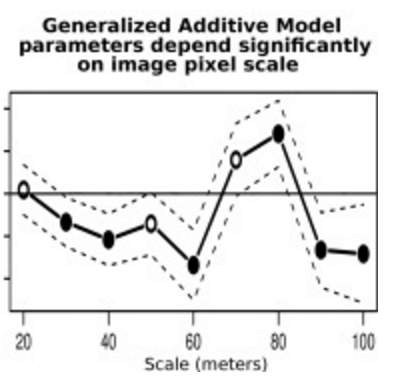 We classified land cover types from 1940s historical aerial imagery using Object Based Image Analysis (OBIA) and compared these maps with data on recent cover. Few studies have used these kinds of maps to model drivers of cover change, partly due to two statistical challenges: 1) appropriately accounting for spatial autocorrelation and 2) appropriately modeling percent cover which is bounded between 0 and 100 and not normally distributed. We studied the change in woody cover at four sites in California’s North Coast using historical (1948) and recent (2009) high spatial resolution imagery.
We classified land cover types from 1940s historical aerial imagery using Object Based Image Analysis (OBIA) and compared these maps with data on recent cover. Few studies have used these kinds of maps to model drivers of cover change, partly due to two statistical challenges: 1) appropriately accounting for spatial autocorrelation and 2) appropriately modeling percent cover which is bounded between 0 and 100 and not normally distributed. We studied the change in woody cover at four sites in California’s North Coast using historical (1948) and recent (2009) high spatial resolution imagery.
Impacts of forest fuel treatments and wildfire on forests
 Monday, December 14, 2015 at 9:33AM
Monday, December 14, 2015 at 9:33AM Tempel, DJ, RJ Gutiérrez, JJ Battles, DL Fry, Y Su, Q Guo, MJ Reetz, SA Whitmore, GM Jones, BM Collins, SL Stephens, M Kelly, WJ Berigan, and MZ Peery. 2015. Modeling short- and long-term impacts of fuel treatments and wildfire on an old-forest species. Ecosphere 6(12) DOI:10.1890/ES15-00234.1

Fuels-reduction treatments are commonly implemented in the western U.S. to reduce the risk of high-severity fire, but they may have negative short-term impacts on species associated with older forests. Therefore, we modeled the effects of a completed fuels-reduction project on fire behavior and California spotted owl (Strix occidentalis occidentalis) habitat and demography in the Sierra Nevada to assess the potential short- and long-term trade-offs. We combined field-collected vegetation data and LiDAR data to develop detailed maps of forest structure needed to parameterize our fire and forest-growth models. We simulated wildfires under extreme weather conditions (both with and without fuels treatments), then simulated forest growth 30 years into the future under four combinations of treatment and fire: treated with fire, untreated with fire, treated without fire, and untreated without fire.
 fire,
fire,  forests,
forests,  last chance,
last chance,  snamp
snamp Mapping relative differences in belowground biomass in wetlands
 Wednesday, December 2, 2015 at 8:00PM
Wednesday, December 2, 2015 at 8:00PM O’Connell, JL, KB Byrd, and M Kelly. 2015. A Hybrid Model for Mapping Relative Differences in Belowground Biomass and Root:Shoot Ratios Using Spectral Reflectance, Foliar N and Plant Biophysical Data within Coastal Marsh. Remote Sensing 7, 16480-16503
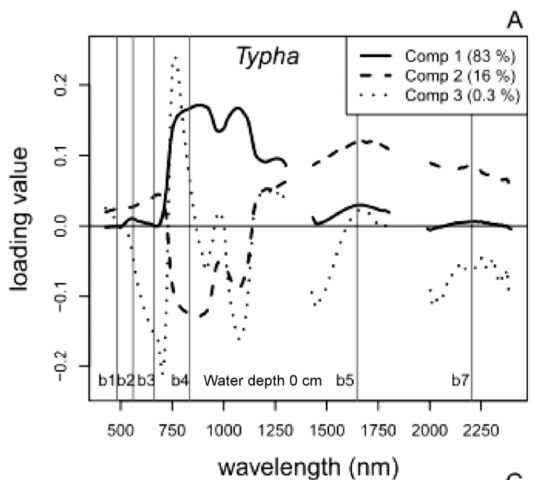 Loadings values of % foliar N from PLS regression of hyperspectral data for Typha spp. Broad-scale estimates of belowground biomass are needed to understand wetland resiliency and C and N cycling, but these estimates are difficult to obtain because root:shoot ratios vary considerably both within and between species. We used remotely-sensed estimates of two aboveground plant characteristics, aboveground biomass and % foliar N to explore biomass allocation in low diversity freshwater impounded peatlands (Sacramento-San Joaquin River Delta, CA, USA). We developed a hybrid modeling approach to relate remotely-sensed estimates of % foliar N (a surrogate for environmental N and plant available nutrients) and aboveground biomass to field-measured belowground biomass for species specific and mixed species models.
Loadings values of % foliar N from PLS regression of hyperspectral data for Typha spp. Broad-scale estimates of belowground biomass are needed to understand wetland resiliency and C and N cycling, but these estimates are difficult to obtain because root:shoot ratios vary considerably both within and between species. We used remotely-sensed estimates of two aboveground plant characteristics, aboveground biomass and % foliar N to explore biomass allocation in low diversity freshwater impounded peatlands (Sacramento-San Joaquin River Delta, CA, USA). We developed a hybrid modeling approach to relate remotely-sensed estimates of % foliar N (a surrogate for environmental N and plant available nutrients) and aboveground biomass to field-measured belowground biomass for species specific and mixed species models.
Book chapter: OBIA history and futures
 Tuesday, November 3, 2015 at 8:14AM
Tuesday, November 3, 2015 at 8:14AM Blaschke, Thomas, Maggi Kelly, and Helena Merschdorf. Object-Based Image Analysis: Evolution, History, State of the Art, and Future Vision. Chapter 14 in Prasad Thenkabail (Editor) Remotely Sensed Data Characterization, Classification, and Accuracies. Taylor & Francis. 678 pp.
More fun with Thomas Blaschke delving into the history of obia and discussing possible new developments. An except of my bit on the Colwell-era antecedants of OBIA:
The conceptual foundations of OBIA are rooted in the 1960s with predigital aerial photography. e spatial information found in digital imagery that is harnessed in the object-based approach, for example, image texture, contextual information, pixel proximity, and geometric attributes of features, were discussed in the 1960s as possible components to yet possible automation of photo interpretation. In his seminal work on aerial photography and early remote sensing applications, Colwell (1965) describes the photo interpretation process as the act of examining photographic images for the purpose of identifying objects and judging their significance. He said that photo interpretation involves the observation of the size, shape, shadow, tone, texture, pattern, and location of the features, as well as the significance of the features, based largely on their interrelationships or association (Colwell 1965). His assessment of the potential for automation of an object recognition process depended on the capacities of a digital scanner and the ability of an algorithm to assess the differences, in photographic tone, between a "blob" and its surroundings (Colwell 1964, 1965). Colwell was an important advisor on the Landsat 1 mission, and his ideas on extraction of meaningful features transferred to his ambitions for the satellite missions (Colwell 1973).
 historic,
historic,  obia,
obia,  remote sensing
remote sensing The HyspIRI sensor for wetland observation
 Monday, October 5, 2015 at 6:25AM
Monday, October 5, 2015 at 6:25AM Turpie, K R, V V Klemas, K Byrd, M Kelly and Y Lo. 2015. Prospective HyspIRI global observations of tidal wetlands Remote Sensing of Environment, 16: 206-217
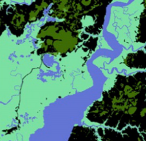 Tidal wetlands are highly productive and act as critical habitat for a wide variety of plants, fish, shellfish, and other wildlife. These ecotones between aquatic and terrestrial environments also provide protection from storm damage, run-off filtering, and recharge of aquifers. For wetland protection and sensible coastal development, there is a need to monitor these ecosystems at global and regional scales. This paper describes how the HyspIRI hyperspectral and thermal infrared sensors can be used to study and map key ecological properties, such as species composition, biomass, hydrology, and evapotranspiration of tidal salt and brackish marshes and mangroves, and perhaps other major wetland types, including freshwater marshes and wooded/shrub wetlands.
Tidal wetlands are highly productive and act as critical habitat for a wide variety of plants, fish, shellfish, and other wildlife. These ecotones between aquatic and terrestrial environments also provide protection from storm damage, run-off filtering, and recharge of aquifers. For wetland protection and sensible coastal development, there is a need to monitor these ecosystems at global and regional scales. This paper describes how the HyspIRI hyperspectral and thermal infrared sensors can be used to study and map key ecological properties, such as species composition, biomass, hydrology, and evapotranspiration of tidal salt and brackish marshes and mangroves, and perhaps other major wetland types, including freshwater marshes and wooded/shrub wetlands.